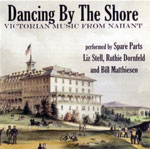 One of my students asked me at class last night whether he owned all of the dance trio Spare Parts’ CDs. Apparently not, as he was surprised to hear about the ten-year-old Dancing by the Shore: Victorian Music from Nahant.
One of my students asked me at class last night whether he owned all of the dance trio Spare Parts’ CDs. Apparently not, as he was surprised to hear about the ten-year-old Dancing by the Shore: Victorian Music from Nahant.
This album seems to get less attention than their others, perhaps because the music on it cannot be pigeonholed into a single era. The word “Victorian” in the title is a bit of a stretch; more than a third of the tracks are technically pre-Victorian.
The tunes for Dancing by the Shore were pulled from sheet music in the archives of the Nahant Historical Society, and the recording was originally advertised as for its benefit. Each piece has some connection to the town of Nahant, Massachusetts, which was a popular island resort in the nineteenth century. The cover image, at left, is a depiction of the Nahant Hotel in the 1850s.
Spare Parts plays as a trio (of varying components), and they make high-quality, musically-engaging recordings good for both dancing and listening. That this album is great for the latter is a given. I will discuss the details of the tracks purely in the context of their usability for historical dancing.
Dancing by the Shore includes:
- two mid-century polkas
- a Regency-style waltz
- an early quickstep and a late march
- a mid-century Lancers Quadrilles
- the Nahant Quadrilles (1836)
Going down the list:
Nahant Polka (1854) & Sea Serpent Polka (1850)
Two lovely midcentury polkas, very danceable at 97 and 99 beats per minute (bpm). The sheet music for the first is at the Lester Levy Sheet Music Collection at Johns Hopkins.
Nahant Waltz (composed before 1823, published late 1820s)
This is a lovely little waltz at a gentle 135 bpm. The liner notes indicate that it was published between 1825 and 1829, but one presumes that it was written before the composer died in 1822. It definitely has an early nineteenth century feel, what Spare Parts describes as the “music-box sound”. It’s close enough time-wise and style-wise that I use it for Regency-era waltzing.
Nahant March (1884) & Col. Lowell’s Quick Step (1838)
There’s not much to be done with either of these in a ballroom other than marching or strolling. Weirdly, the quickstep (a fast march) is recorded at a slow 98 bpm. The march is a better 105 bpm, but is not really long enough for most grand marches. Nor does either tune really attract me for couple dancing. Some quicksteps are usable as galops, but this one is too slow. The Nahant March is almost late enough for a two-step, but to me it lacks the feel of a two-step. Polka would be a possibility, but neither tune has a polka feel and there are two better options right on this album.
The Lancer’s Quadrilles (music 1858)
This set is structured for an American mid-century Lancers. The liner notes do not give the number of bars, but the lengths of each repeat of each figure are 24b-24b-16b-20b-48b, each figure repeated four times, with the appropriate introductions and the 16b coda needed for the final figure. It would also work for variant versions of the famous quadrille, including the New York, Saratoga, and Octagon Lancers. The tempo is suited to the gliding walk of the middle of the century rather than the elaborate steps of earlier decades.
This quadrille was not actually a new recording even when this album first appeared ten years ago. Three of the five tracks were included on The Civil War Ballroom CD, and all five were sold privately as a single-quadrille CD for many years. But it’s helpful to have the full set commercially available. And since this set of tracks was recorded separately, they have a different, richer musical lineup with four extra musicians (two fiddles, cornet, and bass).
The Nahant Quadrilles (1836)
This set is a bit of a problem. It’s not clear whether or not the original music was optionally intended for the First Set of quadrilles, but the length of each figure in this recording (40b-16b-24b-32b-24b, four times each, with 8b introductions) certainly won’t work for it.
Original figures, for a loose definition of “original”, were printed on the sheet music (which is also now online at Lester Levy). As quadrille figures go, they are a mostly-predictable assemblage in an aesthetically displeasing arrangement. And they don’t match the music without ignoring some of the directions on it. I strongly suspect that there was no thought whatsoever behind them — they were just tacked on because people expected quadrille music to come with figures. I’ve reconstructed them, but wouldn’t bother dancing them as printed. If anyone else feels a burning need to do so, be aware that only four of the recorded tracks (for figures 1-2-3-5) are the correct length. The music for the fourth figure is played with a thirty-two bar repeat, rather than the twenty-four bars of the printed figures, so the recording would have to be trimmed to work. The tracks are also at the brisk mid-century tempo, so they would need to be slowed down to use the earlier quadrille steps.
The quasi-reconstruction used to structure the recording was done by my late mentor Patri Pugliese in mid-nineteenth century American quadrille style, presumably because the sponsors of the CD wanted to use these tunes for mid-nineteenth century American balls. Patri was well aware that this was problematic as a reconstruction; we discussed it before his death. I suspect the substantial modifications he made are why it is billed as a “choreography” instead. It’s online here, but I can’t recommend it for historically-accurate dancing. There are stylistic and choreographic alterations to the first two figures and enormous changes to the fourth. Hence the problem with the recording length for that figure.
Personally, I just use these tracks for practice pieces or as alternate music when I’m working with people on a single figure in isolation.
The overall breakdown by era:
- Regency: a waltz
- 1830s: the Nahant Quadrilles (five tracks) and a quickstep
- Mid-century: the Lancers (five tracks) and two polkas
- 1880s: a march
The CD includes liner notes with sources and composers (when known) for the music. The notes are duplicated with some slight changes and additions on Spare Parts’ website. A few audio samples are available there as well.
Overall, I recommend this CD for dancers and certainly for those who just enjoy listening to nineteenth-century dance music. Purchase it from the Nahant Historical Society or at Spare Parts’ website. (Edited 11/28/25 to remove NHS link since it is no longer available in their store.)


Leave a Reply